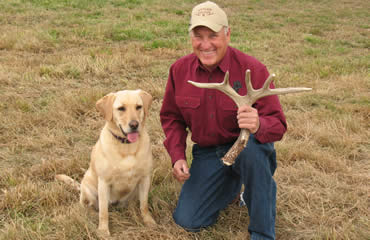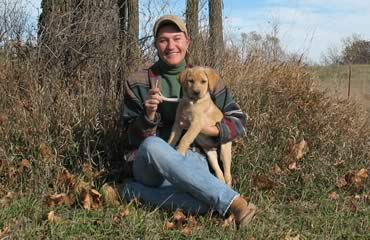Antler hunting is more fun with man’s best friend.
For many whitetail hunters, there isn’t an off season. When we’re not perched 20 feet up a tree, waiting for Mr. Big to walk by, we’re hanging stands, planting food plots or knocking on doors in search of the next great lease. Many look for shed antlers just to pass the days until deer season opens again. For some hunters, finding sheds during the off season is a hobby; for others, it’s an obsession.
For whitetail addicts, finding sheds is like going on an Easter egg hunt. They look behind every tree, under every log, and turn over leaves and brush in hopes of finding that hidden jewel that tells them a monster buck lives in those woods.
Roger Sigler from Antler Dog Kennels in Missouri has found his share of shed antlers over the years. Sigler doesn’t rely on his eyesight alone to find them. He relies on the nose of his canine companion, a habit that started with a special program matching needy animals with needy people.
“I have spent several decades training dogs and other animals,” Sigler said. “I have trained dogs for police departments, for prisons, and have worked with people in California who train dogs for show business. Several years ago, I placed dogs in the care of prisoners. Many of the dogs had been abused or abandoned.
“The dogs lived with the inmates 24 hours a day. It was a great program, and I saw many prisoners’ attitudes change because of the dogs,” Sigler explained.
Sigler wanted to start a training program with the dogs and the prisoners, but he knew the inmates wouldn’t be able to participate in just any training program.
 “I knew the prison system wouldn’t allow me to teach the prisoners how to train the dogs for drug sniffing or as police dogs, so I did some research on what type of specialized training we could use that prisoners could be involved in. My options were to train dogs to be morel mushroom or shed antler hunters. I decided training shed dogs would be fun. Since I enjoyed bird hunting over dogs, it was a perfect fit for me,” Sigler added.
“I knew the prison system wouldn’t allow me to teach the prisoners how to train the dogs for drug sniffing or as police dogs, so I did some research on what type of specialized training we could use that prisoners could be involved in. My options were to train dogs to be morel mushroom or shed antler hunters. I decided training shed dogs would be fun. Since I enjoyed bird hunting over dogs, it was a perfect fit for me,” Sigler added.
The training program was a hit. Eventually, Sigler retired from training police dogs and from the prisoners program. He concentrated his efforts on training shed dogs full-time. Now, he and his dogs find hundreds of sheds every year. Sigler sells puppies and started dogs that are trained to find sheds. In 2010, he will offer finished shed dogs.
According to Sigler, the Labrador retriever is the best breed for finding shed antlers. “Labs are great shed dogs because they love to retrieve,” he said. “They mind well, have a good nose and aren’t high strung like many other hunting breeds.”
Although Sigler believes labs are the best, any dog with a great nose might be able to find sheds.
If you have a lab that you use for bird hunting, Sigler says it’s difficult to teach him to become a shed-finding machine. “My experience taught me a dog that is already a bird hunter will hunt for birds first and foremost,” he said. “If his master takes him shed hunting and the dog stumbles onto some fresh pheasant scent, the dog will quit looking for sheds and concentrate on finding the bird. My dogs are given sheds to play with when they are weeks old. They are trained to be shed dogs first and bird hunters second, which is the way it has to be if you want a dog that excels in finding shed antlers. I’m not saying that a bird dog can’t be trained to find sheds, but the dogs that are best at finding sheds are the ones that started when they were puppies. From early on, we want the dog to know we want them to retrieve antlers; we want them to love fetching antlers.”
In addition, Sigler teaches obedience. The dog needs to know who to listen to and must do what the master says. Sigler also introduces them to water and the sound of a gun. This produces a well-rounded dog that can serve dual purposes. Sigler never uses shock collars or hits his dogs.
“We want our dogs to work for us because they love to retrieve,” Sigler said. “For them, the antler is the reward. Food is used as a reward early on, but we want them to want the sheds. Finding the sheds, returning them to me and getting praised for it is what drives the dogs — not the fear of getting beaten.”
 After a puppy understands basic obedience, the trainer can introduce more time with antlers and teach the puppy to find them. They begin playing fetch with an antler so the dog becomes familiar with antler scent. The goal with this style of training is teaching the dog scent discrimination. An antler is no more important to a dog than a stick. After a dog realizes that a shed is what is wanted, he will start sniffing them out and locating them.
After a puppy understands basic obedience, the trainer can introduce more time with antlers and teach the puppy to find them. They begin playing fetch with an antler so the dog becomes familiar with antler scent. The goal with this style of training is teaching the dog scent discrimination. An antler is no more important to a dog than a stick. After a dog realizes that a shed is what is wanted, he will start sniffing them out and locating them.
Making that transition isn’t always easy, but over time a dog will learn that his job is to find shed antlers,” Sigler said. The best shed dog is the one that understands what you want them to do and becomes obsessed with it. “I have a dog that, every time a visitor comes to the house, runs and finds an antler to play fetch. Getting a dog to become obsessed with the game like that takes time and repetition.”
After a dog is 5 months old, fetches antlers and has basic obedience skills, Sigler concentrates on teaching it to find sheds in larger areas. “We begin in a large indoor arena,” he said. “After the dog consistently finds the sheds in the arena, we move outside, where we let the dog find sheds in an area about half the size of a football field. Next, we move up to an area the size of a football field and then to about a 5-acre piece of land. We then graduate to a 50-acre piece of land.” This training process takes several months.
Sigler points out that during the early stages of the game, the training should take place in a controlled indoors environment where the trainer is always a short distance from the dog and in complete control. Over time, when the dog consistently does as he is told in the controlled environment and finds the hidden sheds, he graduates to a larger playground.
When a dog understands its job, Sigler makes the game a little harder. “After a dog masters finding hidden sheds in large open areas, we sterilize the antlers so they don’t have any human odor on them,” he said. “We hide three or five of them in a field at a time. After they find sheds in a field, we don’t return to that field for a week or more so the dog doesn’t get familiar with the field. The goal is to make them search for the sheds. If we train the dogs in the same field constantly, the dog will learn where to look for the antlers. Constantly switching things up forces the dog to use his eyes and nose to find the antlers.”
As with any good gun dog, it takes years to turn a puppy into a great shed hunter. “The training process is long, but in the end, a well-trained shed dog will double the number of sheds a person can find,” Sigler said.
Sigler said dogs excel at finding shed antlers because it plays to their natural abilities. “Dogs can easily smell antlers, especially if they’re from the previous fall. Sheds that are several years old are harder for a dog to find, but they still sniff them out. The second reason is because they know what they are looking for, and their heads are only inches off the ground. “A dog covers twice as much ground as a person, and they are so close to the ground that they see sheds we would walk right by.”
If you want to increase the number of sheds you find, pick up a lab puppy and start the training process. In 18-24 months, you might have a shed-hunting buddy that loves looking for sheds as much as you do. You also might add a whole new weapon to your deer-hunting arsenal.
Read Recent Articles:
• Confessions of a Cull Hunter: Management bucks provide plenty of challenge at a fraction of the price.
• A Buck's First Year: A whitetail’s first 12 months are fraught with peril, and some won’t survive.
This article was published in the September 2008 edition of Buckmasters Whitetail Magazine. Join today to have Buckmasters delivered to your home.